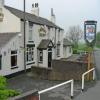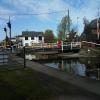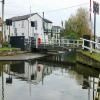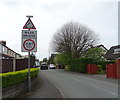
Mooring here is impossible (it may be physically impossible, forbidden, or allowed only for specific short-term purposes).
There is a swing bridge here.
| Red Lion Bridge No 13 | 7¼ furlongs | |
| Shaw's Swing Bridge No 14 | 6¼ furlongs | |
| Westway Bridge No 14A | 5½ furlongs | |
| Methodist Swing Bridge No 15 | 3 furlongs | |
| Maghull Brook Aqueduct No 7 | 1¾ furlongs | |
| Bell's Swing Bridge No 16 | ||
| Lydiate Winding Hole | 2½ furlongs | |
| Dicconson's Bridge No 17 | 3½ furlongs | |
| Lollies Bridge No 17A | 5¾ furlongs | |
| Lydiate Hill Bridge No 18 | 7¾ furlongs | |
| Jackson's Bridge Farm Winding Hole | 1 mile, 2¾ furlongs | |
Amenities here
Why not log in and add some (select "External websites" from the menu (sometimes this is under "Edit"))?
Mouseover for more information or show routes to facility
Nearest water point
In the direction of Wigan Junction
In the direction of Eldonian Village
Nearest rubbish disposal
In the direction of Wigan Junction
In the direction of Eldonian Village
Nearest chemical toilet disposal
In the direction of Wigan Junction
In the direction of Eldonian Village
Nearest place to turn
In the direction of Wigan Junction
In the direction of Eldonian Village
Nearest self-operated pump-out
In the direction of Wigan Junction
In the direction of Eldonian Village
Nearest boatyard pump-out
In the direction of Wigan Junction
Wikipedia has a page about Bell's Swing Bridge
A bell is a directly struck idiophone percussion instrument. Most bells have the shape of a hollow cup that when struck vibrates in a single strong strike tone, with its sides forming an efficient resonator. The strike may be made by an internal "clapper" or "uvula", an external hammer, or—in small bells—by a small loose sphere enclosed within the body of the bell (jingle bell).
Bells are usually cast from bell metal (a type of bronze) for its resonant properties, but can also be made from other hard materials; this depends on the function. Some small bells such as ornamental bells or cowbells can be made from cast or pressed metal, glass or ceramic, but large bells such as a church, clock and tower bells are normally cast from bell metal.
Bells intended to be heard over a wide area can range from a single bell hung in a turret or bell-gable, to a musical ensemble such as an English ring of bells, a carillon or a Russian zvon which are tuned to a common scale and installed in a bell tower. Many public or institutional buildings house bells, most commonly as clock bells to sound the hours and quarters.
Historically, bells have been associated with religious rites, and are still used to call communities together for religious services. Later, bells were made to commemorate important events or people and have been associated with the concepts of peace and freedom. The study of bells is called campanology.





![Bell's Swingbridge [no 16] open for a boat. Carrying Bells Lane over the Leeds & Liverpool canal. The canal guide calls is Bell's Swingbridge, but the online OS map calls it Sumner's Turnbridge. The large-scale OS map surveyed in 1845 calls it Capt. Herd's Bridge (Draw) and the road it carries Wallbrook Lane. by Christine Johnstone – 27 May 2021](https://s1.geograph.org.uk/geophotos/06/90/02/6900245_b519c0d9_120x120.jpg)



























